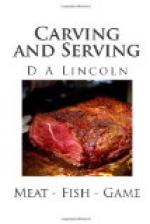It is easier to finish the carving before beginning to serve. An expert carver will have the whole bird disjointed and literally in pieces with a very few strokes of the knife.
ROAST GOOSE.
A green goose neatly trussed and “done to a turn” looks very tempting on the platter; but there is so little meat in proportion to the size of the bird that unless it be skilfully carved only a small number can be served. The breast of a goose is broader and flatter than that of a turkey. It should be carved in a different manner, although many writers give the same directions for carving both.
Place it on the platter with the head at the left. Insert the fork firmly across the ridge of the breast-bone. Begin at the wing and cut down through the meat to the bone, the whole length of the breast. Cut down in the same way in parallel slices, as thin as can be cut, until you come to the ridge of the breast-bone. Slip the knife under the meat at the end of the breast, and remove the slices from the bone. Cut in the same manner on the other side of the breast. Cut through the skin below the breast, insert a spoon and help to the stuffing. If more be required, cut the wing off at the joint. Then tip the body over slightly and cut off the leg. This thigh-joint is tougher, and requires more skill in separating, than the second joint of a turkey. It lies nearer the backbone. But practice and familiarity with its location will enable one to strike it accurately. The wish-bone, shoulder-blade, and collar-bone may be removed according to the directions given for carving roast turkey. Some prefer to remove the wing and leg before slicing the breast.
ROAST DUCK.
Place it in the same position and carve in the same way as a goose.
Begin at the wing, and cut down to the bone in long thin slices, parallel with the breast-bone; then remove them from the bone. The breast is the favorite portion; but the “wing of a flyer and the leg of a swimmer” are esteemed by epicures.
The stuffing is not often desired, but if so it may be found by cutting across below the end of the breast.
Geese and ducks are seldom entirely cut up at the table, as there is very little meat on the back. But often from a seemingly bare carcass enough may be obtained to make a savory entree.
PIGEONS.
These, if small, are served whole. If large, cut through the middle from the neck to the end of the breast and down through the backbone. The bones are thin, and may easily be divided with a sharp knife. When smaller portions are required, cut from the shoulder down below the leg, separating the wing and leg from the body.
PARTRIDGES.
Cut through above the joint of the wing, down below the leg, and remove the wing and leg in one portion. Cut under the breast from the lower end through the ribs to the neck and remove the breast entire. Then divide it through the middle, and, if very plump, divide again. When very small they may be divided through the breast and back into two equal parts.




